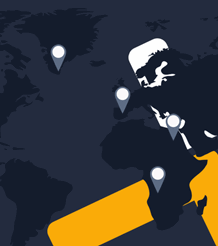
Cape Verde Area Guide
The Islands are Divided Into Two Groups
Barlavento in the north consisting of the islands of Santo Antao (291 sq miles or 754 sq km), Boa Vista Island (240 sq miles or 622 sq km), Sao Nicolau (132 sq miles or 342 sq km), Sao Vicente (88 sq miles or 246 sq km), Sal Island (83 sq miles or 298 sq km), and Santa Luzia (13 sq miles or 34 sq km)
Sotavento in the south, embraces the islands Sao Tiago (Santiago Island) (383 sq miles or 992 sq km), Fogo (184 sq miles or 477 sq km), Maio (103 sq miles or 267 sq km), and Brava (25 sq miles or 65 sq km).
About Cape Verde
Cape Verde is made up of two distinctly different types of islands. Six of the islands, located more to the west, are characterised by their mountainous landscapes, whereas long, sandy beaches distinguish the remaining three. The currency used in Cape Verde is Cape Verde Escudo (CVE).
The main languages spoken are Portuguese and Criuolo, which is a blend of Portuguese and West African. About 80% of the inhabitants are Roman Catholic.
Cape Verde has the coolest temperatures of any country in West Africa and is fairly similar to the Canary Islands. The capital of the islands is Praia, which is on Santiago Island.
The population of Cape Verde is 418,224 and is made up of 39% 0-14 years, 54.3% 15-64 years and 6.8% of over 65 years. Cape Verde’s population consists of Creole (mulatto) 71%, African 28%, European 1%.
The major industries of Cape Verde are food and beverage production, shoe and garment manufacturing, fish processing, salt mining and ship repair. Bananas, corn, beans, sweet potatoes, sugar cane, coffee, peanuts and fish are all produced locally.
Getting To Cape Verde
The easiest way to get to Cape Verde is via Lisbon, Portugal and then directly to Sal Island or Santiago Island. There are many airlines now offering daily flights to Lisbon, not only via the major airports but also through many of the smaller “local” airports. Once in Portugal there are daily flights to the Sal Island which has an International Airport and also now to Santiago Island where the new International Airport has just opened.. Travel to other islands can then be via daily flights or ferry.
From November 2006, direct flights from UK airports initially starting with Birmingham. However there is an 'Open Skies' policy that allows other airlines to fly to Cape Verde and will lower air fares through competition.
History of Cape Verde
The Cape Verde islands were uninhabited on their discovery in 1465 and became part of the Portuguese empire in 1495 and today the majority of its inhabitants are of mixed Portuguese and African ancestry. In 1951 Cape Verde’s status changed from a Portuguese colony to an overseas province, and in 1961 the inhabitants became full Portuguese citizens. In July 1975 the islands gained their independence.
In an effort to take advantage of this proximity to cross Atlantic shipping, the government has embarked on a major expansion of its port. It is also modernising the fishing fleet and enhancing the fish processing industry. These projects are being funded partly by the EU and partly by the World Bank.
The first multi-party elections since independence were held on 13 January 1991 and the African Party for the Independence of Cape Verde lost its majority to the Movement for Democracy Party. Antonio Monteiro won the presidential election and re-held his position in the election in 1996. However the inhabitants became disillusioned with the Government privatisation, continued high employment and poverty and in the 2001 election, Antonio Monteiro was defeated. The African Party for the Independence of Cape Verde regained control with the National Assembly choosing Jose Maria Neves as Head of Government and Pedro Pires as the President.
Cape Verde continues to exhibit one of Africa's most stable democratic governments and one of the Governments guaranteed rights is the security and legal protection of property rights and other assets.
It is suggested that you drink bottled water when in Cape Verde. Although there is no health danger in the islands, diphtheria, hepatitis A and typhoid vaccinations are often recommended. However, a yellow fever vaccination is required when travelling to Cape Verde.
Information Required When Travelling to Cape Verde
Visas
All visitors need a visa to enter Cape Verde
Vaccinations
Although Cape Verde is not a high-risk malaria area, it is advisable to take protection before, and while, you are visiting the islands especially if visiting Santiago Island and Praia. There have been recent outbreaks on these islands. A yellow fever vaccination certificate is a requirement when travelling to Cape Verde.
While not compulsory, vaccination against Typhoid, Diphtheria-Tetanus and Hepatitis A is recommended and will help to ensure that you have an illness free holiday.
Time Zone
The islands are one hour behind GMT
Electricity
Electricity in Cape Verde is 220V, 50Hz. European two pin plugs are the standard.
Weights and Measures
Metric system.
Tel. Dialing Code
00 + 238 + area code + telephone number.
Tourism has been Cape Verde’s main economic activity for several years now and current trends show that this sector will continue to grow year-on-year, considering the numerous projects underway in the islands at present.
The main international airport is located in Sal, although a second international airport opened on the island of Santiago near the capital Praia in November 2005. For the long term, this highlights a bright future for inevitable growth of the tourism throughout the islands and would suggest significant return on investment for those purchasing at the earliest opportunity. An ‘Open Skies’ policy on Cape Verde allows all global airlines to negotiate for landing slots as required, in addition to the Cape Verde national airline TACV, leaving room for competition and competitive air fares.
Tourism in Cape Verde
As your own research has probably led you to believe already, the island of Sal is by far the most developed in terms of tourism facilities and infrastructure, as of early 2006. Predicted to become the ‘Tenerife’ of the Cape Verde islands, Sal is experiencing massive growth in terms of development, infrastructure and in line with these factors, visitor numbers.
Flights
Firstly and most perhaps most importantly, you must consider the accessibility of each Island. Sal has the most established International Airport of all the islands in the Republic. Located in the center of the island, next to a new highway connecting North with South, you are only 15-20 minutes away from the main coastal resorts when you land.
At present there are no scheduled services between the UK and Sal, although there are plans in place to remedy this. Don’t let this put you off however as for investment purposes, this situation is perfect for both UK & Irish investors as prices shall rise dramatically when services are in full operation. When underway, a Tropical Holiday for UK & Irish tourists shall be just 5 and half hours away!
Hotel Accommodation
Sal is the most popular destination for tourists in the Republic with 66.7% of all hotel visitors, highlighting why this is the preferred destination for those in search of a rental market for their chosen investments. There are numerous hotels up and running, and in particular around the resort of Santa Maria. Demand for accommodation, be it hotel or private rentals, far outweighs supply on Sal already. This can only be a good sign for your rental ambitions. Even before UK & Irish direct operations begin in earnest, there is a growing rental market waiting for investors to take advantage from in the form of considerable Italian, Portuguese and surprisingly American visitors, which highlights the impact that direct flight services bring.
The RIU hotel chain, has completed construction of the Club Hotel Riu Funaná, the new reference point in holiday tourism resorts on the island of Sal. This new, five-star, all-inclusive hotel with 500 rooms (with more rooms to follow in 2006) has been conceived as an oasis of comfort next to one of Africa's best beaches. The hotel opened its doors in September 2005, and has not had an empty bed in its first 6 months! If you would like to make a reservation here, it is highly recommended that you make your reservation no less than 2 months prior to arrival to obtain a room.
Another fine hotel on Sal is the Hotel Odjo d’Água, in a beautiful setting at Santa Maria. As a smaller, more exclusive hotel with the greatest attention to detail, there are 34 rooms with 12 suites and full facilities. There is even a small private beach area for guests to enjoy, with panoramic bar and a large pool and solarium surrounded by tropical private gardens.
Activities
Santa Maria & Punta Pretta are regarded as something of a ‘Mecca’ for Kite Surfers. There is a Kite Surfing school, where you may receive tuition of course, and experienced enthusiasts can also hire equipment. Surfers are also in abundance along the coast, with the Atlantic Ocean providing fantastic surfing conditions in certain areas. Visitors can also hire boats to go fishing, or even go Scuba Diving with trained professionals.The developers currently on Sal are placing a huge priority on providing quality facilities for Sal’s tourism base, with the majority of new developments containing or being close to, numerous leisure activities. For example, a brand new Aquapark is being constructed at Santa Maria, a short walk from the beach, bars and restaurants. However, it is around the beach resorts that you shall find the greatest concentration of quality activities for the whole family.
Having tired yourself out with all these activities, you can be rest assured of a fine evening meal at any one of many restaurants around the resort of Santa Maria. The fish dishes in particular are fantastic, having often been caught directly off the local waters within one or two hours of being served! Prices are also very reasonable, being far less than mainland Spain for example.
The exchange rate value of the Cape Verde Escudo is fixed to the Euro (1 Euro = 110.265 Cape Verde Escudos). This has great benefits and is seen by many as the first step to adopting the Euro throughout the Republic. At the moment almost all businesses accept the Euro side by side with their own local CV Escudos.
Healthcare in Cape Verde
Heathcare is obviously something that investors of property in Cape Verde should be aware of and make provisions for. Compared with European and American standards, hospitals are rather primitive on the islands.
Visitors receive free treatment in hospitals on presenting their passports, but it is essential to have health insurance that covers repatriation when going to the Cape Verde islands. Private physicians will expect payment in cash regardless of whether you have insurance or not.
There are limited medical facilities in the islands. Praia and Mindelo have small hospitals but any serious illness would require evacuation to a country with state-of-the-art medical facilities
Medication
Ensure that you have sufficient supplies of any medication you need in their original containers, clearly labelled. It is important that you have a letter from your doctor explaining what medication you take and why. If you are diabetic, for example, and need to carry syringes make sure you have a letter from your doctor explaining the need you have. If you have any allergies especially to penicillin or other medications, ensure that you have your medi-alert bracelet with you.
Food and drink
All water should be regarded as being potentially contaminated. Water used for drinking, brushing teeth or making ice should have first been boiled or otherwise sterilised.
Milk is unpasteurised and should be boiled. Powdered or tinned milk is available and is advised, but make sure that it is reconstituted with pure water.
Only eat well-cooked meat and fish, preferably served hot. Pork, salad and mayonnaise may carry increased risk. Vegetables should be cooked and fruit peeled.
Cuisine in Cape Verde
Fish is a popular element of cuisine in Cape Verde, while meat and fresh vegetables also form a staple part of the national cuisine. Below are some of the most well-known dishes on the islands:
Starters
Melon with local cheese (of the island) Local cheese with dates pickled turtle eggs
Main courses
Tchassina: salted goat meat, eaten with "cachupa" Cachupa: a mixed stew of corn and beans Diable Dentro: pastry with “the devil” inside (tuna, onions, tomatoes, and pastry made from potatoes and flour) Stewed beans: with "feijão longo" (long beans) Goat stew (served at all popular feasts)
Desserts
Water melon and Melon salad Melon fruit preserves Other fruits, eg. bananas, mangos, papayas, guavas, and coconut Local cheese
All drinking water should be bottled, boiled or carbonated and water for brushing teeth or making ice should have first been boiled or sterilised. Milk is unpasteurised and should be boiled. You are advised to avoid all dairy products and foods from street vendors. Meat should always be well-cooked meat.
Be aware that local beer, wine and spirits are commonly available, while soft drinks are unusually expensive.
Driving in Cape Verde
There is an extensive road system on Cape Verde, 2,250 km in all, but only a small part of this is paved. Many of the roads are narrow, winding and cobbled making them wonderful to explore. Often houses are close to the road with children and livestock running about – picturesque to look at, but drivers must be cautious, especially during the rainy season when the cobbles become slippery.
In line with Cape Verde’s improvements to the island’s infrastructure, plans are underway to resurface many of the roads and construction of a new asphalt north-south road on Santiago Island is nearing completion. This will go a long way to improve communications throughout the islands and boost tourism prospects.
In Cape Verde, traffic moves on the right side of the road and at intersections the vehicle on the right has right of way.
Seat-belts must be worn at all times and children under the age of twelve must sit in the back.
Car Hire
Car hire is readily available on the Santiago Island, Fogo Island, Sao Vicente Island and Sal Island. Because of the state of the roads it’s advisable to hire a four-wheel drive.
An international driver’s licence is needed and third-party insurance is required. The insurance disk must be clearly displayed on the vehicle’s windscreen.
Crime And Police in Cape Verde
As in any country, petty thievery and burglary are quite common, but crime rates are relatively low which is reassuring for travelers to the region. Visitors are advised to take normal precautions and avoid large crowds, any political gatherings, and street demonstrations. In the event of an emergency, contact the local police authorities by dialing 132.



